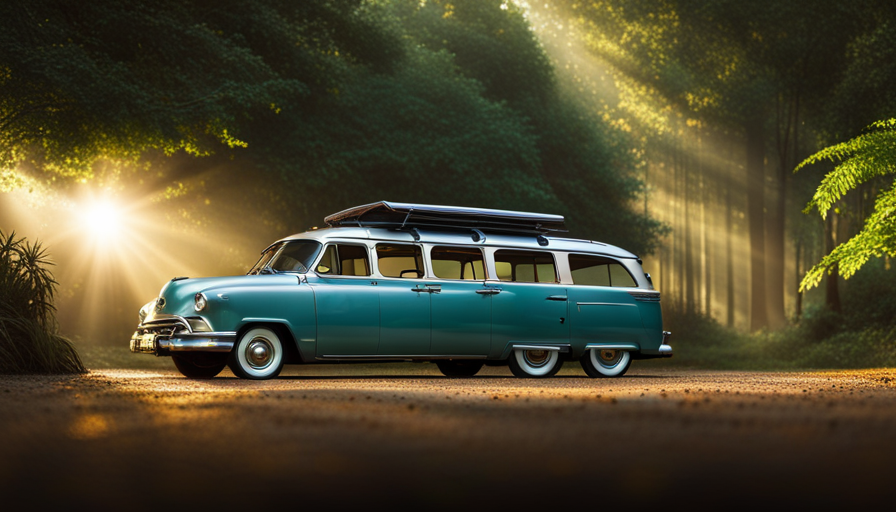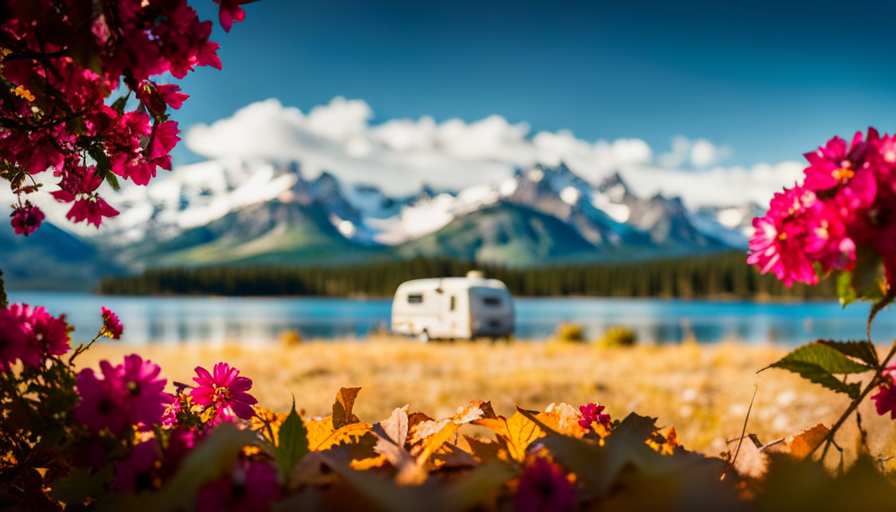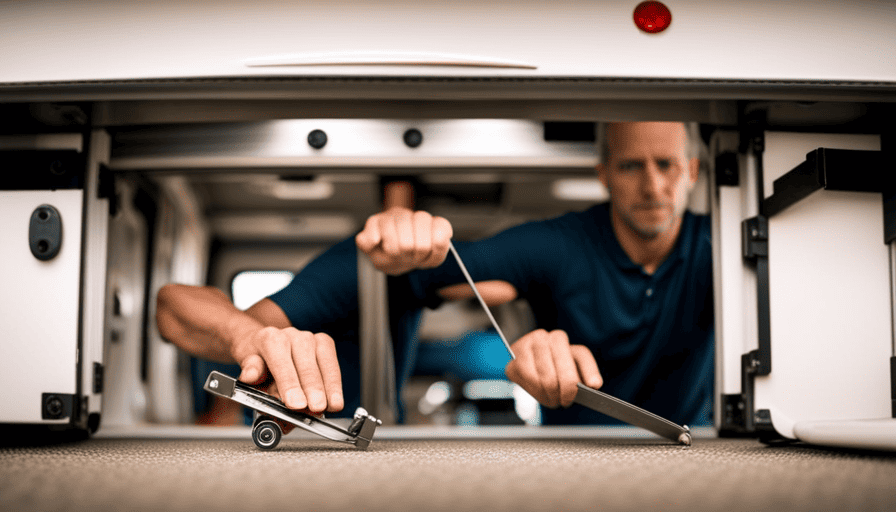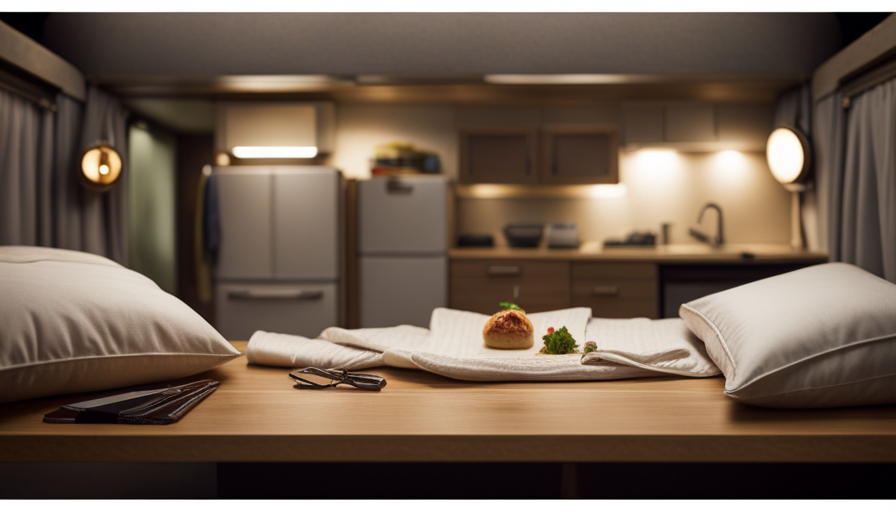Have you ever wondered why someone would desire a stealth camper van?
Well, let me tell you, there’s more to these inconspicuous vehicles than meets the eye.
A stealth camper van is a cleverly designed mobile living space that blends seamlessly into its surroundings, allowing you to camp and explore without drawing unwanted attention.
Despite its unassuming exterior, a stealth camper van offers a world of advantages, from the freedom to park almost anywhere to the ability to live off the grid.
In this article, we will delve into the world of stealth camper vans, exploring their features, advantages, and how you can create your own.
We will also provide tips for living in a stealth camper van, discuss budget-friendly conversion options, and address important safety and legal considerations.
So, if you’re intrigued by the idea of embracing the freedom of stealth camping, keep reading to discover everything you need to know about stealth camper vans.
Key Takeaways
- Stealth camper vans offer the ability to park almost anywhere and live off the grid.
- They are more affordable than traditional RVs.
- Stealth camper vans provide privacy and security.
- They allow for comfortable travel and sleeping without drawing attention.
What is a Stealth Camper Van?
If you’re looking for the ultimate adventure vehicle, a stealth camper van is the perfect solution for blending in while still enjoying all the comforts of home on the road. A stealth camper van is essentially a regular van that’s been converted into a mobile living space. The key feature of a stealth camper van is its ability to blend in with regular vans on the road, making it less conspicuous and allowing for more freedom in terms of parking and camping locations.
There are several advantages to owning a stealth camper van. Firstly, it provides a great deal of flexibility when it comes to travel. You can easily park your van in regular parking lots or on the street without drawing attention to yourself. This opens up a wide range of camping options, from urban areas to remote locations. Additionally, stealth camper vans are typically more affordable than traditional RVs, making them a great option for those on a budget.
However, there are also some disadvantages to consider. Stealth camper vans often have limited space compared to larger RVs, which means you may need to prioritize what you bring on your trips. Additionally, stealth camper vans may not have all the amenities and luxuries of a traditional RV, such as a full bathroom or a large kitchen.
Despite these disadvantages, the advantages of a stealth camper van make it a popular choice for many adventure seekers. From its ability to blend in and its affordability to the freedom it provides in terms of travel and camping locations, a stealth camper van offers a unique and exciting way to explore the world on wheels.
Advantages of a Stealth Camper Van
One major benefit of a stealth camper is the ability to travel and sleep comfortably without drawing unwanted attention. This is especially advantageous for those who enjoy exploring urban areas or want to save money on accommodation during their travels. With a stealth camper van, you can blend in with regular vehicles on the road and park in places where overnight camping may not be allowed.
Imagine being able to park your stealth camper van in a quiet residential neighborhood, waking up to the sound of birds chirping, and enjoying a peaceful morning before starting your day. Or picture yourself parking near a beach and falling asleep to the soothing sound of waves crashing against the shore. The possibilities are endless with a stealth camper van.
Another advantage of a stealth camper van is the flexibility it offers. You have the freedom to travel at your own pace, stopping wherever and whenever you please. Whether you want to explore a new city, visit national parks, or simply take a road trip, a stealth camper van allows you to do so without the hassle of finding accommodation or sticking to a strict itinerary.
Additionally, a stealth camper van provides a level of privacy and security that is not always guaranteed when staying in traditional accommodations. You can have all the comforts of home, including a bed, kitchen, and bathroom, while still maintaining your privacy.
The advantages of a stealth camper van are numerous, from the ability to travel unnoticed to the freedom and flexibility it offers. However, it’s important to consider the potential disadvantages as well, which will be discussed in the next section about the features of a stealth camper van.
Features of a Stealth Camper Van
Packed with amenities and clever design, a stealth camper van boasts a range of features that make it a versatile and comfortable option for travelers. One of the key features of a stealth camper van is its van customization. These vans are carefully modified to maximize space and functionality. They often include custom-built furniture, storage solutions, and compact appliances such as a sink, stove, and refrigerator. The interior layout is designed to optimize living space, with foldable beds, collapsible tables, and multipurpose seating arrangements.
Another important feature of a stealth camper van is its parking strategies. Since stealth campers are designed to blend in with regular vans, they can be parked discreetly in various locations without drawing too much attention. This allows travelers to stay overnight in urban areas, parking lots, or even on residential streets, while still maintaining a low profile.
With these features, a stealth camper van provides a comfortable and inconspicuous way to travel and camp. It offers the freedom to explore different destinations without the need for expensive hotels or campgrounds.
In the subsequent section, we will discuss how to create your own stealth camper van and delve into the process of customizing a van to meet your specific needs and preferences.
How to Create Your Own Stealth Camper Van
When creating our own stealth camper van, there are a few key points to consider.
Firstly, choosing the right van is crucial as it’ll determine the size and layout of our living space.
Insulation and soundproofing are also important to ensure comfort and privacy while on the road.
Lastly, installing essential amenities such as a bed, kitchenette, and bathroom facilities will make our camper van feel like a home away from home.
By carefully considering these factors, we can create a functional and comfortable living space in our stealth camper van.
Choosing the Right Van
Deciding on the perfect van is crucial when creating your ultimate stealth camper. One of the first things to consider is the size of the van. A larger van will provide more space for living, sleeping, and storage, but it may also be more difficult to maneuver and park in urban areas.
On the other hand, a smaller van may be easier to handle but could limit your comfort and storage options. Another important factor to consider is van maintenance. Look for a van that’s reliable and has a good track record for durability. Consider the cost of maintenance and repairs, as well as the availability of parts.
Once you’ve chosen the right van, you can move on to the next step of insulation and soundproofing, ensuring a comfortable and quiet living space.
Insulation and Soundproofing
Now that we’ve chosen the right van, let’s dive into the next important aspect of building a stealth camper van: insulation and soundproofing. Insulation is crucial in keeping the interior temperature comfortable, regardless of the weather outside. There are various insulation techniques you can consider, such as using foam boards, spray foam, or reflective insulation.
Soundproofing is equally important to ensure a peaceful and quiet environment inside the van. You can achieve this by using materials like mass-loaded vinyl, acoustic foam, or sound-deadening mats. Our top recommendations for insulation and soundproofing materials include:
- Closed-cell foam insulation
- Mass-loaded vinyl
- Acoustic foam panels
- Sound-deadening mats
By incorporating these materials, you can create a cozy and noise-free living space inside your stealth camper van.
Now, let’s move on to the next section and explore how to install essential amenities for a comfortable life on the road.
Installing Essential Amenities
To create a comfortable life on the road, you’ll want to explore how to install essential amenities inside your transformed mobile sanctuary. When it comes to essential amenities for a stealth camper van, space-saving solutions are key.
One important consideration is the kitchen area. Compact appliances like a two-burner stove, a small sink with a water storage system, and a mini-fridge are ideal for maximizing space. Additionally, installing a fold-down table or a countertop extension can provide a functional dining area.
For sleeping arrangements, a foldable bed or a convertible sofa can save space during the day and provide a comfortable sleeping area at night.
Don’t forget about bathroom facilities! Portable toilets or composting toilets are popular choices for stealth camper vans.
As you install these essential amenities, keep in mind the importance of space-saving solutions.
Transitioning into the next section, let’s now explore some tips for living in a stealth camper van.
Tips for Living in a Stealth Camper Van
Living in a stealth camper van presents its own unique set of challenges and rewards, so here are some tips to make the experience more enjoyable.
When living off the grid in a stealth camper van, it’s important to embrace a minimalist lifestyle. Keep only the essentials and avoid clutter to maximize your living space. Prioritize your needs and find creative storage solutions to make the most of the limited space available.
One of the key aspects of living in a stealth camper van is staying low-key and blending in. Choose a van that doesn’t attract too much attention and avoid flashy modifications that might give away your living arrangements. It’s also important to be mindful of noise levels and avoid drawing unnecessary attention to yourself.
Maintaining a routine and staying organized is crucial when living in a small space. Set a daily schedule to keep things in order and create designated areas for different activities. Use multi-functional furniture and invest in space-saving gadgets to maximize efficiency.
Living in a stealth camper van can be a rewarding experience, allowing you to explore new places while enjoying the freedom of a minimalist lifestyle. Transitioning from a traditional home to a van may have its challenges, but with careful planning and a positive mindset, it can lead to a fulfilling and adventurous lifestyle.
Now let’s move on to some inspiring stealth camper van conversion success stories.
Stealth Camper Van Conversion Success Stories
In this discussion, we’ll explore some real-life examples of successful stealth camper van conversions. These stories will showcase the creative and innovative designs that van dwellers have come up with to make their living spaces comfortable and functional.
Additionally, we’ll learn valuable lessons from experienced van dwellers, gaining insights into the challenges they faced and the solutions they found.
Real-Life Examples
One prime example of a stealth camper van is the ‘Wanderlust’ – a sleek and covert home on wheels that seamlessly blends into urban environments, making it the perfect getaway vehicle for any adventure seeker. This real-life example showcases the ingenuity and creativity of stealth camper van conversions.
Here are some tips for living in a stealth camper van based on real-life examples:
-
Maximize storage: Utilize every nook and cranny to maximize storage space. Install shelves, hooks, and organizers to keep things tidy and easily accessible.
-
Stay low-key: Opt for a van with a discreet exterior and avoid flashy modifications that draw attention.
-
Blend in: Choose a van color that matches the surroundings and avoid parking in conspicuous areas.
These real-life examples demonstrate the endless possibilities for stealth camper van conversions. In the next section, we’ll explore the creative and innovative designs that take stealth camping to the next level.
Creative and Innovative Designs
Immerse yourself in a world of imagination as you discover the incredible and inventive designs that redefine the concept of mobile living. Stealth camper vans are not limited to conventional layouts and designs; they push the boundaries with innovative ideas and space optimization techniques.
From foldable furniture to hidden compartments, these creative designs maximize every inch of space. Some vans even feature modular setups, allowing the interior to be rearranged according to specific needs. These innovative designs not only make the most out of limited space but also provide a comfortable and functional living environment on the go.
As we explore the lessons learned from experienced van dwellers, we will delve into the practicality and benefits of these unique design concepts.
Lessons Learned from Experienced Van Dwellers
Discover the invaluable wisdom gained from those who’ve embraced the nomadic lifestyle, and let their stories guide you on your own extraordinary journey of mobile living.
When it comes to lessons learned from experienced van dwellers, they’ve faced numerous challenges that can help you navigate the ups and downs of life on the road. They’ve learned:
-
The importance of adaptability in different situations. They’ve encountered various weather conditions, mechanical issues, and unexpected detours, teaching them to be flexible and find solutions on the go.
-
The joy of owning fewer possessions and living with only what’s essential. Living in a van means embracing a minimalist lifestyle. They’ve learned to prioritize experiences over material things.
-
The value of connecting with like-minded individuals who understand the challenges and joys of van life. Van dwellers have formed a tight-knit community where they share knowledge, resources, and support.
As you delve into the world of stealth camper van conversions, these lessons learned will serve as a solid foundation for your own journey. Next, we’ll explore budget-friendly options for stealth camper van conversions.
Budget-Friendly Options for Stealth Camper Van Conversions
A cost-effective approach to stealth camper van conversions is to consider budget-friendly options for materials and equipment. When it comes to creating a space-saving and affordable living space, there are several options to consider.
One of the first things to think about is the type of bed you will have in your van. Instead of purchasing a brand-new bed, consider using a foam mattress or a futon mattress, which can be found at a fraction of the cost.
Additionally, instead of buying expensive storage solutions, look for second-hand options such as plastic bins or baskets that can easily fit into the available space.
Another budget-friendly option is to repurpose materials and equipment. Look for items that you may already have or can find for free or at a low cost. For example, you can repurpose old cabinets or shelves for storage, or use curtains or blankets as window coverings.
Additionally, consider using salvaged or recycled materials for the construction of your camper van, such as reclaimed wood for the interior paneling.
There are many budget-friendly options available for stealth camper van conversions. By considering space-saving solutions and repurposing materials, you can create a comfortable and affordable living space. However, it’s important to also consider safety and legal considerations when converting a van into a camper.
Safety and Legal Considerations
Ensure your peace of mind and comply with all necessary regulations by carefully considering the safety and legality aspects when converting your vehicle into a cozy living space.
It’s important to be aware of safety regulations and legal restrictions to avoid any potential issues and ensure a smooth and hassle-free experience.
When it comes to safety regulations, there are a few key considerations to keep in mind. Firstly, make sure your camper van conversion meets all necessary safety standards, such as having proper ventilation, fire safety measures, and secure anchoring for furniture and appliances. Additionally, it’s important to install smoke and carbon monoxide detectors, as well as fire extinguishers, to ensure the safety of yourself and others inside the vehicle.
In terms of legal restrictions, it’s crucial to research and understand the regulations specific to the area where you plan to camp. Some areas may have restrictions on overnight parking or camping, so it’s important to familiarize yourself with these rules to avoid any potential fines or legal issues. Additionally, be mindful of local noise regulations and respect the privacy and property of others while stealth camping.
By taking these safety and legal considerations into account, you can enjoy your stealth camper van conversion without any worries.
In the next section, we’ll explore alternative stealth camping options that may suit your needs.
Alternative Stealth Camping Options
As we discussed in the previous section, safety and legal considerations are important when it comes to stealth camping in a van. However, if you find that traditional camping spots are not suitable or you simply want to explore different options, there are alternative camping locations available.
One option is to look for dispersed camping areas on public lands. These areas often allow for more flexibility and privacy, making them ideal for stealth camping. National forests and Bureau of Land Management (BLM) lands are great places to start your search. Just make sure to follow any rules or regulations in place to ensure a positive camping experience for yourself and others.
Additionally, there are various stealth camping gear options available that can enhance your camping experience. From window coverings and curtains to portable toilets and solar-powered showers, these gadgets can make your van feel more like a home away from home. Investing in a good quality sleeping bag, camping stove, and portable power bank can also go a long way in ensuring your comfort and convenience while on the road.
Embracing the freedom of stealth camping allows you to explore alternative camping locations and utilize stealth camping gear to enhance your experience. By being mindful of safety, legality, and your impact on the environment, you can enjoy the thrill of van life while respecting the rules and regulations of the areas you visit.
Conclusion: Embrace the Freedom of Stealth Camping
Embrace the exhilarating freedom of stealth camping and unlock a world of endless adventure and unparalleled flexibility on your nomadic journey. Stealth camping offers numerous benefits that make it an attractive option for those seeking a unique and unrestricted travel experience.
The freedom of stealth camping allows you to go wherever your heart desires, without the constraints of traditional camping grounds. You can explore remote and off-the-beaten-path locations that are inaccessible to larger RVs or campers. This opens up a whole new world of possibilities and allows you to discover hidden gems and breathtaking landscapes.
One of the major benefits of stealth camping is the cost savings. By stealth camping, you can avoid expensive campground fees and save money on accommodation. This is particularly appealing for those on a budget or looking to stretch their travel funds.
Another advantage of stealth camping is the flexibility it offers. You have the freedom to change your plans on a whim and stay in different locations every night. This allows for a truly spontaneous and adventurous journey, where you can fully immerse yourself in the beauty of nature.
Embracing the freedom of stealth camping grants you the opportunity to experience unparalleled flexibility and adventure. With the ability to explore remote locations, save money, and enjoy the spontaneity of your travels, stealth camping offers a unique and liberating way to embark on your nomadic journey.
Frequently Asked Questions
Are stealth camper vans legal to use for overnight parking in residential areas?
Stealth camper van regulations vary depending on the specific residential area. Some places may allow overnight parking in residential areas, while others may have restrictions or require permits. It’s important to research and comply with local laws and regulations to avoid any fines or penalties. Using a stealth camper van offers several benefits, such as the ability to blend in with regular vehicles and provide a comfortable and inconspicuous space for overnight stays while on the road.
What are some creative ways to camouflage a stealth camper van to blend in with everyday vehicles?
When it comes to blending in with everyday vehicles, we’ve got some seriously creative tricks up our sleeves for camouflaging a stealth camper van.
From transforming the exterior into a giant pizza delivery van to covering it with a mesmerizing graffiti design, the possibilities are endless!
And when it comes to finding the best locations, think outside the box. Try parking near a construction site or in a busy commercial area where your van won’t raise any suspicions.
How can I ensure privacy and security while living in a stealth camper van?
To ensure privacy and security while living in a stealth camper van, there are various measures we can implement.
For privacy concerns, we can use curtains or blinds on windows, install tinted windows, or even use reflective window coverings.
Additionally, we can create partitions or use room dividers to separate living and sleeping areas.
For security measures, we can install a reliable alarm system, use sturdy locks on doors and windows, and consider adding security cameras or motion sensors.
Are there any specific regulations or restrictions regarding stealth camper vans in national parks or campgrounds?
Regulations and restrictions surrounding stealth camper vans in national parks and campgrounds vary. Some parks and campgrounds have specific rules regarding vehicle size, length of stay, and overnight parking. It’s important to research and familiarize yourself with the regulations of each specific location before planning a trip.
Additionally, some areas may have restrictions on camping in non-designated areas or require permits for overnight stays. Always be respectful of the rules and regulations to ensure a positive experience for both yourself and the environment.
Can a stealth camper van be used as a permanent residence, and what are the challenges associated with it?
When using a stealth camper van as a permanent residence, there are several challenges to consider.
Privacy and security measures become crucial, as you’ll want to protect yourself and your belongings.
Finding suitable parking spots can be difficult, as some areas have restrictions on overnight stays.
Maintaining a comfortable living space with limited amenities is another obstacle.
However, with proper planning and creativity, it’s possible to overcome these challenges and enjoy the freedom of living in a stealth camper van.
Are Pop Up Campers and Stealth Camper Vans Similar in Terms of Features?
Pop up campers and stealth camper vans differ in terms of features, despite both falling under the pop up camper classification. Pop ups are lightweight, towable trailers that expand in size when parked. On the other hand, stealth camper vans are regular vans converted into livable spaces. While both offer versatility, pop ups are more spacious and provide better amenities, while stealth camper vans are more discreet and maneuverable for stealth camping.
Conclusion
In conclusion, stealth camping offers an incredible sense of freedom and adventure. Imagine waking up to the sound of birds chirping, surrounded by nature, with the ability to travel wherever your heart desires.
With a stealth camper van, you can have all of this and more. Whether you choose to convert your own van or opt for a budget-friendly option, the possibilities are endless.
So why wait? Embrace the freedom of stealth camping and embark on a journey like no other. What are you waiting for? Start exploring today!










